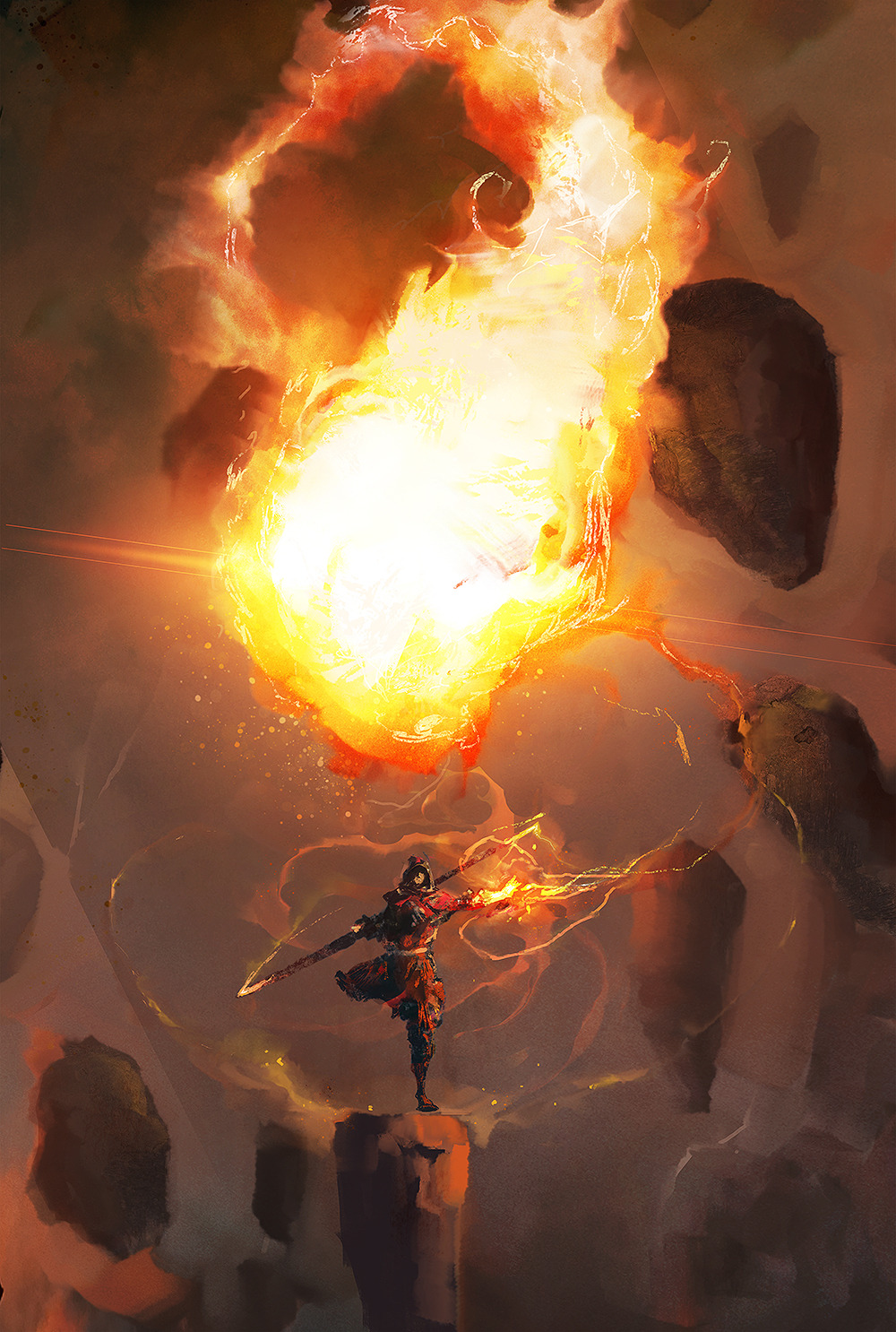
Cultivator
An elf sits alone at the top of a cliff overlooking a small town. He keeps an eye on the movement of those below as he devotes the rest of his attention to sharpening and fletching arrows. A flash of light catches his eye. The signal. The elf picks up his spyglass to find the target. He catches sight of the dishevelled human stumbling from a worn barn.
As the elf starts to nock an arrow a soft, blue light begins to suffuse his eyes and arms. Slowly, the glow spreads to the arrow, all while the elf keeps the human in his sights. As the light reaches the tip of the arrow, he breathes out and releases his fingers.
The arrow fires so powerfully from the bow that the elf hears the sound moments after he's shot it. It tears through the air as it charges toward its target, near unseen in its speed. The human walks several steps before he realizes there is a hole in his chest. As he falls to the ground with a wordless gurgle, the elf nocks another arrow and waits, eyes on the barn door.
Ki: Magic Refined
A cultivator will learn early in their training that ki is created when they condense the arcane energies that make up the magic in the world around them. It can be absorbed into the body and refined in one's core, which normally resides just above the navel.
Breathing techniques are used to refine ki, and there are as many breathing techniques as actual techniques. Regardless of how it's gathered, ki is the driving force behind a cultivator's power. It is used to augment their bodies and the world around them much like magic. This energy has birthed a multitude of techniques that cultivators use to prove themselves.
However, a true cultivator is someone who not only uses ki, but becomes it. This is the true goal of all those who follow this path.
Devoted Bodies. Devoted Minds
A cultivator will spend their entire life, often resolved to die training or fighting, focusing on their abilities. They will dedicate themselves to a single technique, spending their time improving it and making it their own. They train by fighting and constantly looking for the moment inspiration hits, driving their techniques to new limits.
A cultivator must have a strong body to handle the stress that training and ki cycling puts on it. They must also have a mind just as strong to learn, improve, and apply what combat teaches.


Cultivator
| Level | Proficiency Bonus | Features | Ki Pool |
|---|---|---|---|
| 1st | +2 | Fighting Style, Unarmored Defense | - |
| 2nd | +2 | Techniques, Technique Feature, Ki | 2 |
| 3rd | +2 | Cultivator's Aura | 3 |
| 4th | +2 | Ability Score Increase | 4 |
| 5th | +3 | Extra Attack | 5 |
| 6th | +3 | Technique Feature | 6 |
| 7th | +3 | Ki Flood | 7 |
| 8th | +3 | Ability Score Increase | 8 |
| 9th | +4 | Of Sound Mind and Body | 9 |
| 10th | +4 | Technique Feature | 10 |
| 11th | +4 | Ki Conduction | 11 |
| 12th | +4 | Ability Score Increase | 12 |
| 13th | +5 | Ki Flood(two uses) | 13 |
| 14th | +5 | Technique Feature | 14 |
| 15th | +5 | Unnerving Calm | 15 |
| 16th | +5 | Ability Score Increase | 16 |
| 17th | +6 | Critical Assault | 17 |
| 18th | +6 | Ki Flood(three uses) | 18 |
| 19th | +6 | Ability Score Increase | 19 |
| 20th | +6 | Ki Incarnate | 20 |
Class Features
As a cultivator, you gain the following class features
Hit Points
- Hit Dice: 1d8 per cultivator level
- Hit Points at 1st Level: 8 + your Constitution modifier
- Hit Points at Higher Levels: 1d8 (or 5) + your Constitution modifier per cultivator level after 1st
Proficiencies
- Armor: Light armor, medium armor, shields
- Weapons: Simple weapons, martial weapons
- Tools: Calligrapher's Supplies
- Saving Throws: Intelligence, Constitution
- Skills: Choose three skills from Acrobatics, Athletics, Deception, History, Intimidation, Sleight of Hand, Stealth, Survival
Equipment
You start with the following equipment, in addition to the equipment granted by your background:
- (a) a martial weapon and a Shield or (b) two Martial Weapons
- (a) a Longbow and 20 arrows or (b) two handaxes
- (a) a scholar's pack or (b) an explorer’s pack
Fighting Style
You adopt a particular style of fighting as your specialty. Choose a Fighting Style from the list of optional features. You can't take the same Fighting Style option more than once, even if you get to choose again.
Archery
You gain a +2 bonus to attack rolls you make with ranged weapons.
Close Quarters Shooter
When making a ranged attack while you are within 5 feet of a hostile creature, you do not have disadvantage on the attack roll. Your ranged attacks ignore half cover and three-quarters cover against targets within 30 feet of you. You have a +1 bonus to attack rolls on ranged attacks.
Defense
While you are wearing armor, you gain a +1 bonus to AC.
Dueling
When you are wielding a melee weapon in one hand and no other weapons, you gain a +2 bonus to damage rolls with that weapon.
Great Weapon Fighting
When you roll a 1 or 2 on a damage die for an attack you make with a melee weapon that you are wielding with two hands, you can reroll the die and must use the new roll, even if the new roll is a 1 or a 2. The weapon must have the two-handed or versatile property for you to gain this benefit.
Interception
When a creature you can see hits a target that is within 5 feet of you with an attack, you can use your reaction to reduce the damage the target takes by 1d10 + your proficiency bonus (to a minimum of 0 damage). You must be wielding a shield or a simple or martial weapon to use this reaction.
Thrown Weapon Fighting
You can draw a weapon that has the thrown property as part of the attack you make with the weapon. In addition, when you hit with a ranged attack using a thrown weapon, you gain a +1 bonus to the damage roll.
Two-Weapon Fighting
When you engage in two-weapon fighting, you can add your ability modifier to the damage of the second attack.
Unarmed Fighting
Your unarmed strikes can deal bludgeoning damage equal to 1d6 + your Strength modifier. If you strike with two free hands, the d6 becomes a d8. When you successfully start a grapple, you can deal 1d4 bludgeoning damage to the grappled creature. Until the grapple ends, you can also deal this damage to the creature whenever you hit it with a melee attack.
Unarmored Defense
While you are not wearing any armor, your Armor Class equals 10 + your Dexterity modifier + your Intelligence modifier. You can use a Shield and still gain this benefit.
Techniques
You begin to devote your life to cultivating and perfecting one of many techniques. Choose a technique detailed at the end of the class description. Your choice grants you features at 2nd Level and again at 6th, 10th, and 14th levels.
Ki
Starting at 2nd Level, your cultivation affords you to access to the condensed form of pure magic. Your access to this energy is represented by your ki pool. Your cultivator level determines the amount of ki you have, as shown in the ki Pool column of the cultivator table. You can spend ki to fuel various technique and stance features.
When you spend ki, that ki is unavailable until you finish a short or Long Rest, at the end of which you condense more ki, refilling your core. You must spend at least 30 minutes of the rest meditating to regain ki.
Some of your technique and stance features require your target to make a saving throw to resist the feature’s effects. The saving throw DC is calculated as follows:
Cultivator Save DC
Cultivator's Aura
Upon reaching 3rd level, your intense training and tempering of your body has left you with the ability to physically exude your skill and power. As long as you have at least 1 ki point remaining, you can use your Constitution in place of Charisma when making Charisma based skill checks.
Extra Attack
Beginning at 5th Level, you can Attack twice, instead of once, whenever you take the Attack action on Your Turn.
Ki Flood
Starting at 7th level, as a bonus action, you can saturate your body with ki allowing you to gain and activate the benefits of the internal and external stance abilities at the same time. Also, while this ability is active, you may spend a ki point to take an additional reaction once per round. This feature lasts for 1 minute and when it ends, you can’t move or take actions until after your next turn, as your body seizes from the ki forced through your veins.
You can use this feature twice between long rests starting at 13th level and three times between long rests starting at 18th level.
Of Sound Mind and Body
At 9th level, your mastery over ki allows you to better safeguard yourself mentally and physically. When you are subjected to an effect that allows you to make a Constitution or Intelligence saving throw to take only half damage, you may spend a ki point to instead take no damage if you succeed on the saving throw.
You do not gain the benefit of this ability when you are unconscious or sleeping.
Ki Conduction
Upon reaching 11th level, you have learned to convert your skill into power. Once per day, you can use an action to recover an amount of ki equal to twice your proficiency bonus.
Unnerving Calm
At 15th level, when your enemies meet your eyes, they see only calm and certain death awaiting them. You may spend 3 ki points and use your reaction to roll an Intimidation check opposed by an opponent's Insight. If you win then you have advantage on your attacks against that opponent until the beginning of your next turn.
Once this ability has been used on a creature, it can't be used on that creature again for 24 hours. You must be able to see this creature and it must have sight.
Critical Assault
Upon reaching 17th level, you are able to enhance yourself allowing you to follow up brutal damage with precise, deadly strikes. When you score a critical hit on an enemy, you may spend 3 ki points as part of that attack. Your attacks against that same opponent gain advantage until the end of your next turn.
Ki Incarnate
Beginning at 20th level, you are ki made flesh. You become immune to poison, disease, and when you roll for Initiative and have no ki remaining, you regain an amount of ki equal to your Intelligence modifier.


Techniques
Iaijutsu
A master of the Iaijutsu spends their time standing or kneeling. Sitting is a past time for those asking to be killed. With bodies tensed like coiled springs, these cultivators are faster than lightning and just as deadly. Users of this technique have mastered the art of the sword draw to the point that most will never see the blade before their death. A speed born of talent, skill, or perseverance have made these cultivators some of the deadliest swordsman to hold a blade.
Flash Draw
While assuming either of your stances you may draw and sheathe one weapon as part of any and every attack you make. This weapon must deal slashing damage, and cannot have the heavy property. Enemies can also provoke opportunity attacks from you even if you haven't drawn your weapon.
Stances
Starting at 2nd level, your technique allows you access to knowledge on how to use ki internally for defensive abilities and externally for offensive ones.
You can choose the external or internal stance when you roll for initiative. Switching between stances is a bonus action. Unless otherwise noted, you can only use the abilities and benefits granted by each stance while you're in it. Most stances have static passives that are active while in that stance and activated abilities.
You are unable to use stances while you are incapacitated. If you are incapacitated while in a stance, you may regain either stance as a bonus action
Internal Stance
-
As a bonus action, you may spend 2 ki points to gain 10 feet of blindsight and a 10 foot reach. This ability lasts until you move out of the square in which you activated it.
-
As an action, you can add your proficiency bonus to AC until the beginning of your next turn. You may, instead, spend an amount of ki equal to half of your proficiency bonus rounded up to forgo an attack instead of an action to activate this ability.
-
As long as you haven't moved since the beginning of your last turn you may use the dodge action as a bonus action.
External Stance
-
As an action, you can double the number of dice for your next attack. You may spend an amount of ki equal to half of your proficiency bonus rounded up to forgo an attack instead of an action to activate this ability.
-
When you would attack an enemy who has not yet acted this combat you deal an additional 1d6 damage on your attacks. This damage increases to 1d8 at 10th level and 1d10 at 15th.
-
If you start combat in this stance you may spend a ki point to gain advantage on your next initiative check.
Iai-goshi
Upon reaching 6th level, you master the first position of counter attacking. Using your strike to foil an enemies. When an enemy rolls to attack you, as a reaction, you can make an attack roll. If your roll is equal to or greater than the attack, it is canceled. You may use this ability after an enemy rolls, but before damage is dealt.
Tachi-ai
When you reach 10th level, your practice has allowed you to master the Tachi-ai stance of this technique. As an action, you sheathe your weapon and assume this position to ready yourself until the beginning of your next turn.
If an enemy attacks you or moves into your reach you can use your reaction to make a full attack action. Each successful strike deals an additional 1d8 damage.
Kennokabe
At 14th level, you have developed a skill epitomizing the perfect defense and offense. As an action, you may spend 5 ki points to create what appears to be a wall of blades to those around you. Until the end of next turn you can make an attack roll for every attack roll an opponent makes against you. If your result is equal to or higher than the attacker's roll, the attack is canceled. If your roll is higher than a melee attack roll or a ranged attack roll made adjacent to you, then you cancel the attack and also use your roll as a counterattack.

















Falling Phoenix Technique
Cultivators learning the Falling Phoenix technique have a predilection for fire. Some particularly enjoy raining it from the heavens, and seize on any chance to do so.
Stances
Starting at 2nd level, your technique allows you access to knowledge on how to use ki internally for defensive abilities and externally for offensive ones.
You can choose the external or internal stance when you roll for initiative. Switching between stances is a bonus action. Unless otherwise noted, you can only use the abilities and benefits granted by each stance while you're in it. Most stances have static passives that are active while in that stance and activated abilities.
You are unable to use stances while you are incapacitated. If you are incapacitated while in a stance, you may regain either stance as a bonus action
Internal Stance:
- You gain resistance to fire damage as long as you are in this stance.
-
When you are attacked by an enemy adjacent to you, you may spend a ki point as a reaction. You gain a burning cloak that lasts until the beginning of your next turn. Any adjacent enemy who successfully hits you takes 1d6 fire damage.
-
When an enemy makes an attack against you, you may spend a ki point as a reaction and cover yourself in flames to give the attacker disadvantage.
External Stance:
-
As a bonus action, you may spend a ki point to cause your weapons to deal an extra 1d4 of fire damage until the end of the turn.
-
As an action you can create a burst of phoenix shaped fire to rain on an enemy. This action is a ranged attack with a range of 30 feet. You are proficient with it, and you add your Intelligence modifier to its attack and damage rolls. It deals 1d6 fire damage plus an additional 1d6 fire for each ki point you spend. This attack ignores cover if the enemy is not under a structure or around a corner.
-
You may spend a ki point as a bonus action to cause your weapon to deal fire damage instead of normal damage, and it gains 5 feet of reach. This reach cannot stack with any other abilities that cause you to gain reach.
Phoenix Fall
Starting at 6th level, you may call down a flock of phoenixes on a flock of foes. As an action, you may spend 2 ki points to rain flaming phoenixes in a 20-foot-radius sphere centered on a point. Each creature in range must make a Dexterity saving throw. A target takes 3d6 fire damage on a failed save, or half as much damage on a successful one. You may spend ki in 2 point increments to increase this damage by 3d6.
Phoenix's Vestment
Upon reaching 10th level, you gain resistance to fire damage. Whenever you are in your internal stance you instead gain immunity to fire damage.
Weaving Wings
Beginning at 14th level, you gain the ability to produce phoenix wings to burn your enemies. As an action, you may spend 5 ki points to grow phoenix wings that spread 10 feet to each side of you, lasting until the end of the turn. You gain a fly speed of 60 feet while these wings are active. Also, any enemy that these wings touch must make a Dexterity saving throw. A target takes 4d6 fire damage on a failed save, or half as much damage on a successful one. An enemy can only be hit by this ability once in a turn.



Flash Wind
Masters of this technique use the wind to devastating effect. Often seen as blurs moving across the battlefield, rarely stopping and constantly attacking. Users often augment themselves and the area around them using powerful winds generated or controlled by ki.
Stances
Starting at 2nd level, your technique allows you access to knowledge on how to use ki internally for defensive abilities and externally for offensive ones.
You can choose the external or internal stance when you roll for initiative. Switching between stances is a bonus action. Unless otherwise noted, you can only use the abilities and benefits granted by each stance while you're in it. Most stances have static passives that are active while in that stance and activated abilities.
You are unable to use stances while you are incapacitated. If you are incapacitated while in a stance, you may regain either stance as a bonus action
Internal Stance:
-
All forms of movement increase by 10 feet. Your Long Jump and High Jump (See Athletics) distance is multiplied by your proficiency bonus rounded to the nearest 5 foot increment.
-
When you are the target of a ranged attack, you may spend a ki point as a reaction to give the attacker disadvantage as a wind wall briefly springs up around you.
-
As part of your movement you may spend a ki point to jump up to your movement speed. Your movement does not provoke opportunity attacks if you make a Strength (Athletics) check equal to half the total distance.
External Stance:
-
As an action, you may spend a ki point to use the wind to push back all creatures within 10 feet of you. Each creature in range makes a Strength saving throw. On a failed save they are pushed back 10 feet + 5 feet for every 2 points they fail by.
-
If you have moved at least 15 feet directly towards a creature this turn, you may spend a ki point and make a Strength (Athletics) check DC equal to that creature's AC. On a success, your next attack has advantage.
-
After an attack action, you may spend a ki point as a bonus action to make an additional attack. If you're wielding two weapons you may spend 2 ki points and make two attacks instead.
Gale Force
Beginning at 6th level, you can create an intense burst of wind to accelerate your thrown weapons and projectiles. As a bonus action, you may spend 2 ki points to increase the damage die of your ranged weapons by one step. E.g. A longbow would instead deal 1d10 damage instead of 1d8.
Mounted Storm
At 10th level, you gain a fly speed equal to your walking speed. You must stay within 10 feet of the ground to use this ability.
Release the Cyclone
Upon reaching 14th level, you may spend 4 ki points to instantly call upon the power of a storm. You generate a 30 foot cone of wind. Each creature within the area must make a Strength saving throw. A creature takes 4d8 bludgeoning damage and is thrown 20 feet in a random direction on a failed save, or half damage and is not moved on a successful save.

















Ki Blades
Everything has an energy. The water of an ocean crashing on a beach. The heat of a sun warming a forest. A cultivator using the Ki Blades technique develops the ability to feel and manipulate a sharper kind of energy. This is the energy given off by wind on a blade. A body carved into. These cultivators wield sword energy to create spectral weapons out of thin air. Abilities culminating in the creation of a storm that rips unfortunate enemies into fragments.
Spectral Weapon
While assuming these stances, you can create a spectral weapon that floats next to you. You gain a new attack option that you can use with the Attack action. This special attack is a melee attack with a range of 10 feet. You are proficient with it, and you add your Intelligence modifier to its attack and damage rolls. It deals 1d6 of force damage. This die becomes a d8 at 5th level and a d10 at 15th.
When you gain the Extra Attack feature, this special attack can replace one attack you make as part of the Attack action.
Stances
Starting at 2nd level, your technique allows you access to knowledge on how to use ki internally for defensive abilities and externally for offensive ones.
You can choose the external or internal stance when you roll for initiative. Switching between stances is a bonus action. Unless otherwise noted, you can only use the abilities and benefits granted by each stance while you're in it. Most stances have static passives that are active while in that stance and activated abilities.
You are unable to use stances while you are incapacitated. If you are incapacitated while in a stance, you may regain either stance as a bonus action



Internal Stance
-
When another creature damages you with a melee attack, you can use your reaction to roll your spectral weapon die. You reduce the damage by the number you roll on your spectral weapon die + your Intelligence modifier.
-
As part of your movement, you can use your spectral weapon as a platform. You double your jump height and length. You may also spend a ki point to gain advantage on your next Athletics check.
-
When a creature misses you with a melee attack, you can use your reaction and spend a ki point to throw that creature off balance with your spectral weapon. The next attack made against this enemy has advantage.
External Stance
-
As part of an attack you make with your spectral weapon you may spend any amount of ki points. Give the weapon an additional 5 feet of reach for every ki spent.
-
As an action, you can cause your spectral weapon to encircle you, attacking those around you. You may spend 2 ki points to make a spectral weapon attack on each creature adjacent to you.
-
As a bonus action, you cover and enlarge your normal and spectral weapons with ki, making them even more destructive. Until the end of the turn, you may increase the damage die of your spectral weapon and the weapons you're holding by 1 step. For example, your spectral sword goes from a d6 to a d8, and your longsword goes from a d8 to a d10.
Precision Thrust
At 6th level, you can follow up devastating attacks with a spectral assault. When you score a critical hit with your normal weapons, you can immediately make an additional attack with your spectral weapon.
Journey Blade
Beginning at 10th level, you are able to solidify your spectral weapon to soar through the air. Once per day, you may spend 3 ki points as an action and gain a flight speed equal to your movement speed. This ability lasts for a number of minutes equal to half your level.
Blade Squall
Starting at 14th level, you can create a deadly storm of blades. As an action, you may spend 5 ki points to make a number of spectral weapon attacks equal to your proficiency bonus. Once you use this feature, you must finish a short or long rest before you can use it again.
Hollow Dawn
Stances
Starting at 2nd level, your technique allows you access to knowledge on how to use ki internally for defensive abilities and externally for offensive ones.
You can choose the external or internal stance when you roll for initiative. Switching between stances is a bonus action. Unless otherwise noted, you can only use the abilities and benefits granted by each stance while you're in it. Most stances have static passives that are active while in that stance and activated abilities.
You are unable to use stances while you are incapacitated. If you are incapacitated while in a stance, you may regain either stance as a bonus action
Internal Stance
-
You can manipulate the natural shadows to use the Hide action without cover in dim or dark light.
-
When you are attacked, as a reaction, you may spend a ki point and roll a Deception check with a DC equal to the attack roll. If successful, the attack misses. You may use this only once per round.
-
If you are stealthed or hidden, you can use an action to dash and stay hidden as long as you end your movement behind cover or in dim light or darkness.
External Stance
- As an action, you may spend a ki point and utilize the shadows around an enemy to blind them. The target must succeed on a Constitution saving throw or be blinded until the end of their next turn.
-
As a bonus action, you may spend a ki point to coat your weapons in darkness. They deal an additional 1d4 of necrotic damage until the end of your turn. At 5th level, this die becomes a 1d6.
-
As part of your attack action, you may spend a ki point and forgo an attack to trip an enemy with shadows. The target must make a Dexterity saving throw or fall prone.
Shadow Slide
Beginning at 6th level, you can use the dark to slide along the ground like a living shadow. As part of your movement, you may spend 2 ki points to move up to your movement speed as a shadow on a surface as long as you are in dim light or darkness. You may move horizontally or vertically, but if your movement ends on a wall then you fall to the ground.
This movement does not provoke opportunity attacks.
Umbra's Cloak
Starting at 10th level, you begin to wear the dark like a mantle. You may use the Hide action as a bonus action.
Becloud the Sun
Upon reaching 14th level, when you attack an enemy who can't see you, you may spend 5 ki points and have the target make a Constitution saving throw if you hit. The target takes an additional 8d6 of necrotic damage on a failure or half as much on a successful save as you force wave after wave of shadow into the body.



Flying Fortress
Flying Fortress adepts are taught that the best offense is the most perfect defense. They learn that the shield should be the first weapon you grab, not the sword. Disciples of the Flying Fortress strive to combine the Immovable Object and the Unstoppable Force.
Shield Throw
While assuming either of these stances, you gain a new shield attack option that you can use with the Attack action. This special attack is a melee or ranged attack with a range of 20 feet. You are proficient with it, and you add your Intelligence modifier to its attack and damage rolls. Its damage die is a d8. The shield returns to you at the end of your turn.
When you gain the Extra Attack feature, this special attack can replace one attack you make as part of the Attack action.
Stances
Starting at 2nd level, your technique allows you access to knowledge on how to use ki internally for defensive abilities and externally for offensive ones.
You can choose the external or internal stance when you roll for initiative. Switching between stances is a bonus action. Unless otherwise noted, you can only use the abilities and benefits granted by each stance while you're in it. Most stances have static passives that are active while in that stance and activated abilities.
You are unable to use stances while you are incapacitated. If you are incapacitated while in a stance, you may regain either stance as a bonus action
Internal Stance:
-
You have advantage on all saves and checks against being moved.
-
When you are hit by an opponent adjacent to you, you may spend a ki point as a reaction to push that enemy back. Make a Strength (Athletics) contest against your attacker. If you win then the enemy is pushed back 5 feet + an additional 5 feet for every 2 points you win by.
-
When an attack is made against you, you may spend a ki point as a reaction to increase your AC by 1 until the start of your next turn, including against the triggering attack. At 5th, 10th, and 15th level, you may spend additional ki points for more AC. For example, at 10th level, you may spend up to 3 ki points for +3 AC.
External Stance:
-
When you take the help action, you may spend a ki point and cause an enemy to gain disadvantage against target adjacent ally until the beginning of your next turn.
-
You may spend a ki point as an action to make a shield charge. As part of this action, you must move at least 10 feet, but up to double your movement speed, towards an enemy and make a melee shield attack (as detailed above). This attack instead deals 1d8 bludgeoning damage + twice your Intelligence modifier.
This ability can't cause you to move more than double your movement in a single turn. Starting at 5th level, you may add an extra 1d8 bludgeoning damage for each additional ki point you spend.
-
As an action you may spend a ki point and make a single ranged shield attack (as detailed above). If hit, your target must make a Strength saving throw or be knocked prone. Regardless of this result, the next attack made against this target has advantage.


Shield Wall
Starting at 6th level, when you are in the area of an area spell or ability that requires a Dexterity saving throw, like fireball or a breath weapon, you may use your reaction to automatically succeed on it. If you are between the spell or ability and an ally when you use this ability (such as an ally being directly behind you while a dragon uses its breath weapon in front of you), then that ally gains advantage on their save.
Once you use this feature, you must finish a Long Rest before you can use it again.
Fortress Crash
Upon reaching 10th level, you may spend 4 ki points as an action to hurl your shield with all your might. Make a ranged melee shield attack (as detailed above). If the attack is successful the target takes 3d8 bludgeoning damage and makes a Strength saving throw or is knocked prone. Any creature of the same size as you or smaller has disadvantage on this save.
The Unstoppable Force
At 14th level, you have turned your immovable object into an unstoppable force. When you use your Fortress Crash ability, you may spend an additional 3 ki points to hit a number of targets equal to your Intelligence modifier. Each target must be no more than 20 feet from the previous.
Taiji
You must have the Unarmed Fighting style to take this subclass.
Known as the technique that pursues the oneness of everything. The ultimate whole of every state. Taiji disciples practice balancing opposing forces to achieve perfect harmony with the universe. These disciples, while seemingly docile in their slow and inexorable practice of forms, use their mastery of these skills with extreme and deadly efficiency.
Stances
Starting at 2nd level, your technique allows you access to knowledge on how to use ki internally for defensive abilities and externally for offensive ones.
You can choose the external or internal stance when you roll for initiative. Switching between stances is a bonus action. Unless otherwise noted, you can only use the abilities and benefits granted by each stance while you're in it. Most stances have static passives that are active while in that stance and activated abilities.
You are unable to use stances while you are incapacitated. If you are incapacitated while in a stance, you may regain either stance as a bonus action
Internal Stance
-
When you are hit with radiant damage you may spend a ki point to capture some of the incoming energy, lessening its effect on you. You have resistance to the triggering damage until the start of your next turn.
-
You may spend a ki point to add an additional 1d4 radiant damage to your unarmed strikes until the end of the turn. While this ability is active, your unarmed strikes may be used to heal for the additional radiant damage. This damage increases to 1d6 at 5th level, 1d8 at 10th, and 1d10 at 15th. You can only have one of these additional damage abilities active at a time.
-
Whenever you use a class ability to reduce or negate any amount of damage done to you or an ally, you may use a bonus action to make an additional attack until the end of your next turn.
External Stance
- When you are hit with necrotic damage you may spend a ki point to capture some of the incoming energy, lessening its effect on you. You have resistance to the triggering damage until the start of your next turn.
-
You may spend a ki point to add an additional 1d6 necrotic damage to your unarmed strikes until the end of the turn. This damage increases to 1d8 at 5th level, 1d10 at 10th, and 2d6 at 15th. You can only have one of these additional damage abilities active at a time.
-
Whenever you use a class ability to reduce or negate any amount of damage done to you or an ally, you may use a bonus action to make an additional attack until the end of your next turn.
Duality
Upon reaching 6th level, you grow your knowledge of the whole in life's many aspects, allowing you to harness the world's numerous dualities. After taking a short or long rest, you may switch the elements of your stance from radiant and necrotic damage, to fire and cold damage respectively for internal and external stances. You may choose psychic and force damage respectively at 12th level.
Balance in Nature
Beginning at 10th level, you are able to enact your will upon elemental forces around you. When you and allies within 15 feet of you are subject to an area attack of an element which you have chosen for the day, as a reaction you may spend a ki point for yourself and each ally within range. You all gain resistance to the damage type for the attack.
Wuji
Starting at 14th level, you have reached the pinnacle of balance. When you are Ki Flooded you also gain immunity to both your stance elements for the duration of the ability. When you negate damage while Ki Flooded you deal an additional 1d4 damage of that type until the end of your next turn.






























Eternal Shot
Practitioners of the Eternal Shot spend their time honing their aim to take out foes from tremendous distances. Due to the nature of combat, however, they also garner abilities to deal with enemies that have them in their sights.
Stances
Starting at 2nd level, your technique allows you access to knowledge on how to use ki internally for defensive abilities and externally for offensive ones.
You can choose the external or internal stance when you roll for initiative. Switching between stances is a bonus action. Unless otherwise noted, you can only use the abilities and benefits granted by each stance while you're in it. Most stances have static passives that are active while in that stance and activated abilities.
You are unable to use stances while you are incapacitated. If you are incapacitated while in a stance, you may regain either stance as a bonus action
Internal Stance:
-
You gain advantage on perception checks to see things over long distances as long as you are in this stance.
-
When a physical projectile is shot towards you, you may spend a ki point as a reaction to try and knock it out of the air. Make an attack roll, if your roll is higher than the attacker's then the projectile is deflected. You must be using a ranged or thrown weapon to use this ability
-
You may spend a ki point as you hit an enemy with a ranged or thrown weapon. If you successfully hit, then that opponent has disadvantage on their next ranged attack against you.
External Stance:
-
You double the normal range increment of ranged and thrown weapons as long as you are in this stance.
-
As you attack with a ranged or thrown weapon you may spend a ki point. If you're at least 30 feet from your target then your attacks deal an extra 1d4 of weapon damage. This becomes a d6 at 5th level.
-
As an action, you may spend ki points to shoot multiple projectiles at once. Make one attack for each ki point spent up to your Intelligence modifier. Every attack after your second in this turn has disadvantage. This disadvantage cannot be negated.
Ki Charged Projectiles
At 6th level, any projectile you shoot or weapon you throw counts as magical for the purpose of overcoming resistance and immunity to nonmagical attacks and damage.
Angled Assault
Upon reaching 10th level, if you successfully deflect a ranged attack with your internal stance, you may spend an additional ki point and use your attack roll on the enemy who made the attack or someone with 10 feet of that enemy. If the roll hits their AC then roll weapon damage as normal.
The Eternal Shot
Beginning at 14th level, you have begun to master the technique's namesake ability. You may spend 5 ki points as an action and shoot or throw a projectile that forms a line 100 feet long and 5 feet wide blasting out from you in a direction you choose. Each creature in the line must make a Dexterity saving throw. A creature takes 8d6 weapon damage on a failed save, or half as much damage on a successful one.


Spirit Pack subclass
A majority of cultivators learn this technique is structured and well thought out manners. They call to spirits, be it specific or otherwise, and commune with them. They then spend a majority of their time working together, training together, and fighting for their lives together. However, there are others who find their way to this path in a more...sorrowful manner. People who've lost partners, siblings, guardians, find themselves calling to the spirits left behind. Calling to the truth behind an existence. Calling to a life to carry on. Regardless of how cultivators find themselves on this particular path, one thing is certain. A Spirit Pack never fights alone.
Spirit Animals
Starting at 2nd level when you choose this subclass, you gain two spiritual companions. These spirits can be either existing beasts, or ones summoned to you through a special ritual during a long rest, but upon becoming your companions, gain a magical bond with you that grants them special powers. Your spirits can have the general appearance of any beast, but their stats are determined by the stat block below and the traits selected.
Your spirits share the same health pool, but count as different targets in regards to single target and area effects. Getting both spirits in one area of effect ability or spell, does not deal double the damage.
While in or out of a single stance only one spirit is summoned. Switching spirits is done whenever you would switch stances. Using your Ki Flood ability summons your second spirit to this plane. Both spirits will act on your initiative, following the normal rules stated below. If a class ability costing ki would apply to one spirit, you may spend double that amount for it to affect both.
Spirit Companion
Medium beast, unaligned
- Armor Class 10 + its Dexterity + its Proficiency.
- Hit Points 5 + ([Beast's Constitution Modifier + 5] * Cultivator Level)
- Speed 30ft.
STR DEX CON INT WIS CHA 14 (+2) 14 (+2) 14 (+2) 4 (-3) 10 (+0) 6 (-2)
- Skills Athletics +4 (Proficiency), Perception +2 (Proficiency)
- Senses passive perception 12
- Languages Understands cultivator’s languages, but cannot speak
Actions
Attack. Natural Weapon: +4(Strength + Proficiency) to hit, reach 5ft., one target. Hit 1d8 + 2 (Strength)
__
You can add two of the following traits to the stat block, you may pick a separate two traits for each spirit:
Amphibious
Your Companion gains a swimming speed equal to its movement speed, and the ability to breathe underwater.
Blindsight
Your Companion gains a Blindsight of 10 feet.
Tunneling
Your Companion gains a burrowing speed equal to half its movement speed. It can choose to leave a tunnel behind when it burrows or not.
Flying: Prerequisite: selected beasts appearance must have have wings.
Your Companion's size is Small, and it gains a flying speed equal to its movement speed.
Keen Senses:
Your companions can add twice their proficiency in the Perception skill.
Pack Tactics:
Your Companions have advantage on an Attack roll against a creature if at least one of your Companion's allies is within 5 feet of the creature and the ally isn't Incapacitated.
Quick
Your companions are particularly swift, their movement speed becomes 40 feet.
Sneaky
Your companions gain proficiency in the Stealth and Deception skills.
Simian Nature
Your companions gain a climbing speed equal to their movement speed, proficiency with throwing rocks (ranged weapon, 1d4 bludgeoning damage, thrown(20/60), and the ability to hold small items.
Spiderclimb
Your companions can climb difficult surfaces, including upside down on ceilings, without needing to make ability checks, and ignores movement restrictions caused by webbing.
Venomous:
Your beasts' attacks deal an additional 1d4 poison damage.
You also add an additional two points to the spirits Strength, Dexterity, or Constitution score. Whenever you gain the Ability Score Improvement class feature, your companion’s abilities also improve. Your companion can increase one ability score of your choice by 2, or it can increase two ability scores of your choice by 1. As normal, your companion can’t increase an ability score above 20 using this feature (your Companions have a maximum ability score of 20 for Strength, Dexterity, or Con, and 10 for Intelligence, Wisdom, or Charisma). You must choose the same ability score improvements for both companions.
The spirits obey your commands as best as they can. They takes their turn on your initiative, though they don't take an action unless you command them to. On your turn, you can verbally command (no action required) the spirits to move and to take the Dash, Disengage, Dodge, or Help action, or use your action to command them to take the Attack action. Once you have the Extra Attack feature, you can make one weapon attack yourself when you command the spirits to take the Attack action.
Your spirits regain 6 + their constitution modifier hit points every time you expend a hit die, and regain all their health at the end of a long rest. If you are incapacitated or absent, they act on their own, focusing on protecting you and themselves. They do not require your command to use their reaction to make an opportunity attack. If you don't issue a command, they take the Dodge action.
If your Companions die, they can be revived by recalling their spirits and causing them to reform at the end of a long rest at full health.
Stances
Starting at 2nd level, your technique allows you access to knowledge on how to use ki internally for defensive abilities and externally for offensive ones.
You can choose the external or internal stance when you roll for initiative. Switching between stances is a bonus action. Unless otherwise noted, you can only use the abilities and benefits granted by each stance while you're in it. Most stances have static passives that are active while in that stance and activated abilities.
Internal Stance
-
You can use your reaction to have your companion use the Help action.
-
When you are the target of an attack you may, as a reaction, spend a ki point to swap places with your spirit. The attack is made against the spirit in your place.
-
As long as you are within 10 feet of your spirit you add +1 to both your ACs. This increases to +2 at 10th level.
External Stance
- Once per round, if your spirit is within 10 feet of someone who successfully attacks a creature adjacent to the spirit you may spend a ki point. Your companion can make a free attack against that same enemy.
-
As an action you may spend a ki point to have your spirit pounce an enemy. It can move up to twice its movement speed and make one attack at advantage. The next attack made on your spirit is made at advantage.
-
Whenever your spirit makes a successful attack with advantage, the target of the attack must make a Strength saving throw DC 8 + Proficiency Bonus or be knocked prone.
Infused Spirits
Upon reaching 10th level, you learn to strengthen your spirits with an influx of ki. As an action, you may spend 3 ki points per spirit. Their size doubles in all dimensions, and their weights multiply by eight. This growth increases their size categories by one—from Medium to Large, for example. If there isn’t enough room for the spirits to double their sizes, they attain the maximum possible sizes in the space available. Until this ability ends, they also have advantage on Strength checks and Strength saving throws. Their natural weapons also deal 1d4 extra damage.
A Pack as One
At 14th level, your pack has reached new spiritual heights. Whenever you would use your Ki Flood ability, you may instead spend 5 ki points to fuse your two spirits with yourself. You gain a number of temporary hit points equal to half your companions hit points. Your attacks deal an additional 1d6 damage, and you gain up to two traits from your spirits. This ability lasts for one minute or until your temporary hit points are depleted.
If you revert as a result of dropping to 0 hit points, any excess damage carries over to your normal form and you are separated from your spirits.
While this ability is active you may also activate your Infused Spirits ability targeting yourself, but no stance abilities can be used in this form passive or otherwise.


Multiclassing
Should you want to multiclass into Cultivator, the prerequisites and proficiencies are listed below:
- Prerequisite: 13 Intelligence and 13 Strength or Dexterity
- Proficiencies gained: Light armor, Medium armor, Shields, Simple weapons, Martial weapons
Artist Credits (in order of appearance)
- q by zhihui Su
- White Lord of Blades by Mikhail Palamarchuk
- Dagger Man by amanohana925
- Ashe by TheMaestroNoob
- Reigning Fire by Cobaltplasma
- Mu Yanling by Yongjae Choi
- DnD Captain America by FrostLlamzon
- Dark Elf by Hyun sung oh / Louie_OH
- Okan by Johnathan Chong
- Yin/Yang by Sagong Ji Cheol
- Prosthetics girl by 羅 光佑
- The Wolf Clan by einiv
- Swordsman by Loiza.Chen